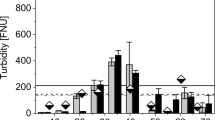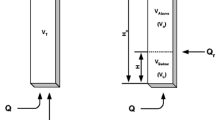Abstract
Effluents form the swine livestock industry contain a high concentration of pollutants and require complex treatment systems. The most recurrent form to treat Swine wastewater is by a conventional anaerobic–aerobic treatment. For example, an up-flow anaerobic blanket sludge reactor followed by an activated sludge reactor. However, in many countries, a high percentage of producers are small or medium-sized farms that can afford neither complex treatment systems nor specialized operations. The present study assessed the performance of a novel and different combinations of treatment processes, based on changing the anaerobic systems that require a specialized operation for one very simple to operate for farm owners. The assessed system is composed by a septic tank in combination with an up-flow anaerobic filter packed with volcanic rocks and an aerobic biofilter packed with waste wood chips. The effect of the hydraulic residence time and the volumetric organic loading in the septic tank and up-flow anaerobic filter and the effect of surface hydraulic loading in the aerobic biofilter were also evaluated. The system efficiently removed chemical oxygen demand (86–93%), total suspended solids (91–97%), volatile suspended solids (86–97%), and ammoniacal nitrogen (86–87%), showing a constant removal efficiency under a VOL of between 5 and 14.6 kg COD m−3 d−1in the up-flow anaerobic filter. The advantages of this system are that the packing materials can be available in rural zones and are sustainable; the whole system is cost-effective and easy to handle; thus, farmers can operate and maintain it with their own means.






Similar content being viewed by others
References
APHA, AWWA, WPCF. (2005). Standard methods for examination of water and wastewater. Washington DC: American Public Health Association, American Water Works Association and Water Environment Federation.
Bitton, G. (2005). Wastewater microbiology. Department of Environmental Engineering Science. University of Florida, Gainesville. Wiley-Liss, Florida.
Bock, E., Schmidt, I., Stüven, R., & Zart, D. (1995). Nitrogen loss caused by denitrifying Nitrosomonas cells using ammonia or hydrogen as electron donors and nitrite as electron acceptor. Archives of Microbiology, 163, 16–20.
Buelna, G., Dubé, R., & Turgeon, N. (2008). Pig manure treatment by organic bed biofiltration. Desalination, 231, 297–304.
Capassi, C. M., Costa, J. C., Cantil, M. E. S., Navarro, R. S., Romera, Y. F., Subtil, E. L., & Chagas, R. K. (2013). Sizing of a UASB reactor for the treatment of swine wastewater. Revista de Saúde, Meio Ambiente e Sustentabilidade, 8(2), 19–39.
Chernicharo de Lemos, C. A. (2007). Anaerobic reactors. England: IWA.
Ding, W., Cheng, S., Yu, L., & Huang, H. (2017). Effective swine wastewater treatment by combining microbial cells with flocculation. Chemosphere, 182, 567–573.
Duda, R. M., da Silva-Vantini, J. M., Scattolin de Mello-Varani, L., Lemos, A., Franco-Ferro, M. V., Tiraboschi de- Oliveira, M. I., & Alves, R. (2015). A balanced microbiota efficiently produces methane in a novel high-rate horizontal anaerobic reactor for the treatment of swine wastewater. Bioresource Technology, 197, 152–160.
Garzón-Zúñiga, M. A., & Buelna, G. (2014). Swine wastewater characterization and its treatment by different processes in Mexico (Caracterización de aguas residuales porcinas y su tratamiento por diferentes procesos en México). Revista Internacional de Contaminacion Ambiental, 30(1), 65–79.
Garzón-Zúñiga, M. A., Lessard, P., Aubry, G., & Buelna, G. (2005). Nitrogen elimination mechanisms in an organic media aerated biofilter treating pig manure. Environmental Technology, 26, 361–371.
Hernández, A., Ramírez, E., & Garzón-Zúñiga, M. A. (2011). Performance of a non-aereated biofilter coupled to an aereated biofilter for pig wastewater treatment (Desempeño de un biofiltro sin aire acoplado con uno aireado Para tratar aguas residuales porcícolas). Ingeniería Sanitaria y Ambiental AIDIS Argentina, 112, 44–49.
INEGI (2013) La porcicultura en Sonora: Censo Agropecuario 2007. In INEGI (ed.), Ganado, cría de (Porcino)- Sonora. 1st edn. INEGI, México.
Jetten, M., Horn, S., & Van Loosdrecht, M. (1997). Towards a more sustainable municipal wastewater treatment system. Water Science and Technology, 35(1), 171–180.
Kesik, M., Blagodatsky, S., Papen, H., & Butterbach-Bahl, K. (2006). Effect of pH, temperature and substrate on N2O, NO and CO2 production by Alcaligenes faecalis p. Journal of Applied Microbiology, 101, 655–667.
Ladu, J., & Lü, X. (2014). Effects of hydraulic retention time, temperature, and effluent recycling on efficiency of anaerobic filter in treating rural domestic wastewater. Water Science and Engineering, 7(2), 168–182.
Liu, S., Yang, F., Xue, Y., Gong, Z., Chen, H., Wang, T., & Su, Z. (2008). Evaluation of oxygen adaptation and identification of functional bacteria composition for Anammox consortium in non-woven biological rotating contactor. Bioresource Technology, 99, 8273–8279.
Masi, F., Rizzo, A., Martinuzzi, N., Wallace, S., Van Oirschot, D., Salazzari, P., Meers, E., & Bersciani, R. (2017). Upflow anaerobic sludge blanket and aerated constructed wetlands for swine wastewater treatment: a pilot study. Water Science and Technology, 76(1), 68–78.
Mendez-Novelo, R., Castillo-Borges, E., Vazquez-Borges, E., Briceño-Perez, O., Coronado-Peraza, V., Pat-Canul, R., & Garrido-Vivas, P. (2009). Estimación del potencial contaminante de las granjas porcinas y avícolas del estado de Yucatán. Ingeniería, 13(2), 13–21.
Metcalf, & Eddy. (2003). Wastewater engineering, treatment and reuse. New York: McGraw-Hill.
Nacheva, M. P., Pantoja, M. R., & Serrano, L. E. A. (2011). Treatment of slaughterhouse wastewater in upflow anaerobic sludge blanket reactor. Water Science and Technology, 63(5), 878–884.
Noyola, A., Paredes, M. G., Morgan-Sagastume, J. M., & Güereca, L. P. (2016). Reduction of greenhouse gas emissions from municipal wastewater treatment in Mexico based on technology selection. Clean: Soil, Air, Water, 44(9), 1091–1098.
Rajagopal, R., Rousseau, P., Bernet, N., & Béline, F. (2011). Combined anaerobic and activated sludge anoxic/oxic treatment for piggery wastewater. Bioresource Technology, 102, 2185–2192.
Rim, J. M., & Han, D. J. (2010). Process development for nitrogen removal of swine waste. Water Science and Technology, 42(3–4), 239–246.
Robertson, L.A. (1988). Aerobic denitrification and heterotrophic nitrification in Thiosphaera pantotropha and other bacteria. Ph. D. Thesis University of Technology. Delft, Netherlands.
Strous, M., Kuenen, G., & Jetten, M. (1999). Key physiology of anaerobic ammonium oxidation. Applied and Environmental Microbiology, 65, 3248–3250.
Suto, R., Ishimoto, C., Chikyu, M., Aihara, Y., Matsumoto, T., Uenishi, H., Yasuda, T., Fukumoto, Y., & Waki, M. (2017). Chemosphere, 167, 300–3007.
Tang, Y., Fujimura, Y., Shigematsu, T., Shigeru, M., & Kenji, K. (2007). Anaerobic treatment performance and microbial population of thermophilic Upflow anaerobic filter reactor treating awamori distillery wastewater. Journal of Bioscience and Bioengineering, 104(4), 281–287.
Van Dongen, L., Jetten, M., & van Loosdrecht, M. (2001). Sharon – Anammox process for treatment of ammonium rich wastewater. Water Science and Technology, 44(1), 153–160.
Vanotti, M. B., Szogi, A. A., & Vives, C. A. (2008). Greenhouse gas emission reduction and environmental quality improvement from implementation of aerobic waste treatment systems in swine farms. Waste Management, 28, 759–766.
Xiangyang, Q., Shubiao, W., Zhongqiang, W., Zhuang, Z., & Renjie, D. (2015). Seasonal and daily emissions of methane and carbon dioxide from a pig wastewater storage system and the use of artificial vermiculite crusts. Biosystems Engineering, 131, 15–22.
Zhang, S., Liu, F., Luo, P., Xiao, R., Chen, J., Chen, L., & Wu, J. (2019). Does rice straw application reduce N2O emissions from surface flow constructed wetlands for swine wastewater treatment. Chemosphere, 226, 273–281.
Zhao, B., Li, J., Buelna, G., Dubé, R., & Le Bihan, Y. (2016). A combined upflow anaerobic sludge bed and trickling biofilter process for the treatment of swine wastewater. Environmental Technology, 37(10), 1265–1275.
Funding
This work was supported by the Mexican Council of Science and Technology (Conacyt: Award Number CB-2008-01-000103922), The Mexican Institute of Water Technology (IMTA), and the National Polytechnic Institute (IPN).
Author information
Authors and Affiliations
Corresponding author
Ethics declarations
Conflict of Interest
The authors declare that they have no conflict of interest.
Additional information
Publisher’s Note
Springer Nature remains neutral with regard to jurisdictional claims in published maps and institutional affiliations.
Rights and permissions
About this article
Cite this article
Escalante-Estrada, V.E., Garzón-Zúñiga, M.A., Valle-Cervantes, S. et al. Swine Wastewater Treatment for Small Farms by a New Anaerobic-Aerobic Biofiltration Technology. Water Air Soil Pollut 230, 145 (2019). https://doi.org/10.1007/s11270-019-4200-3
Received:
Accepted:
Published:
DOI: https://doi.org/10.1007/s11270-019-4200-3




